uniapp中如何實現手勢密碼功能
手勢密碼是一種常見的手機解鎖方式,也可以應用在uniapp開發的行動應用程式中。在uniapp中,我們可以使用canvas來繪製手勢路徑,並透過監聽使用者的手勢操作來實現手勢密碼的功能。本文將介紹uniapp中如何實現手勢密碼功能,並提供相關程式碼範例。
- 建立頁面結構
首先,我們需要建立一個包含canvas元素的頁面結構。在pages目錄下新建GestureLock資料夾,並在該資料夾下建立GestureLock.vue檔案。在GestureLock.vue檔案中,加入以下程式碼:
<template>
<view class="container">
<canvas
ref="gestureCanvas"
canvas-id="gestureCanvas"
:style="{ width: '100%', height: '100%' }"
></canvas>
</view>
</template>
<script>
export default {
onLoad() {
const query = uni.createSelectorQuery().in(this);
query.select('.container')
.boundingClientRect((res) => {
const canvasWidth = res.width;
const canvasHeight = res.height;
this.canvasWidth = canvasWidth;
this.canvasHeight = canvasHeight;
this.ctx = uni.createCanvasContext('gestureCanvas');
// 绘制初始画面
this.drawBackground();
})
.exec();
},
methods: {
// 绘制背景
drawBackground() {
this.ctx.setFillStyle('#F5F5F5');
this.ctx.fillRect(0, 0, this.canvasWidth, this.canvasHeight);
this.ctx.draw();
},
},
};
</script>
<style>
.container {
width: 100vw;
height: 100vh;
}
</style>在上述程式碼中,我們在頁面中加入了一個canvas元素,透過ref屬性指定了該元素的引用名稱為gestureCanvas。並透過canvas-id屬性指定了canvas元素的id為gestureCanvas。在元件的onLoad方法中,我們使用uni.createSelectorQuery().in(this)來取得canvas元素的寬高,並儲存在元件的data中。在組件的methods中,我們定義了一個繪製背景的方法drawBackground(),用於在canvas上繪製一個灰色背景。
- 監聽手勢操作
接下來,我們需要監聽使用者的手勢操作,包括手指的按下、移動和放開。我們可以透過uniapp的手勢事件來實現這項功能。在GestureLock.vue檔案的methods中,加入以下程式碼:
methods: {
// ...
// 手指按下事件
onTouchStart(event) {
const touch = event.touches[0];
const startX = touch.clientX;
const startY = touch.clientY;
// ...
},
// 手指移动事件
onTouchMove(event) {
const touch = event.touches[0];
const moveX = touch.clientX;
const moveY = touch.clientY;
// ...
},
// 手指松开事件
onTouchEnd() {
// ...
},
},在上述程式碼中,在methods中加入了三個方法,分別對應手指按下事件、手指移動事件和手指鬆開事件。在手指按下事件中,我們透過event.touches[0]取得到目前手指的位置,並儲存在startX和startY變數中,以便後續使用。在手指移動事件中,我們透過event.touches[0]取得到目前手指的位置,並儲存在moveX和moveY變數中,以便後續使用。在手指放開事件中,我們可以進行手勢密碼的驗證。
- 繪製手勢路徑
下一步,我們需要在canvas上繪製手勢路徑。在GestureLock.vue檔案的methods中,加入以下程式碼:
methods: {
// ...
// 绘制手势路径
drawGesturePath() {
this.ctx.clearRect(0, 0, this.canvasWidth, this.canvasHeight);
this.drawBackground();
// ...
this.ctx.setStrokeStyle('#337ab7');
this.ctx.setLineWidth(3);
this.ctx.setLineCap('round');
this.ctx.setLineJoin('round');
for (let i = 0; i < this.gesturePath.length - 1; i++) {
const pointA = this.gesturePath[i];
const pointB = this.gesturePath[i + 1];
this.ctx.beginPath();
this.ctx.moveTo(pointA.x, pointA.y);
this.ctx.lineTo(pointB.x, pointB.y);
this.ctx.stroke();
}
this.ctx.draw(true);
},
},在上述程式碼中,我們在drawGesturePath方法中,先使用this.ctx.clearRect()方法來清空canvas上的內容,然後呼叫drawBackground方法來繪製灰色背景。接下來,我們使用this.ctx.setStrokeStyle()方法設定線條的顏色,使用this.ctx.setLineWidth()方法設定線條的寬度,使用this.ctx.setLineCap()方法設定線條的端點樣式,使用this. ctx.setLineJoin()方法設定線條的連接處樣式。然後,透過遍歷gesturePath數組,依序繪製手勢路徑的各個線段。最後,使用this.ctx.draw(true)方法將繪製的內容即時顯示在canvas上。
- 完整的手勢密碼功能實作
最後,我們將前面的程式碼整合在一起,即可實現完整的手勢密碼功能。在GestureLock.vue檔案中,加入以下程式碼:
<template>
<view class="container">
<canvas
ref="gestureCanvas"
canvas-id="gestureCanvas"
:style="{ width: '100%', height: '100%' }"
@touchstart="onTouchStart"
@touchmove="onTouchMove"
@touchend="onTouchEnd"
></canvas>
</view>
</template>
<script>
export default {
data() {
return {
canvasWidth: 0,
canvasHeight: 0,
ctx: null,
startX: 0,
startY: 0,
moveX: 0,
moveY: 0,
gesturePath: [], // 手势路径的点集合
};
},
onLoad() {
const query = uni.createSelectorQuery().in(this);
query.select('.container')
.boundingClientRect((res) => {
const canvasWidth = res.width;
const canvasHeight = res.height;
this.canvasWidth = canvasWidth;
this.canvasHeight = canvasHeight;
this.ctx = uni.createCanvasContext('gestureCanvas');
// 绘制初始画面
this.drawBackground();
})
.exec();
},
methods: {
// 绘制背景
drawBackground() {
this.ctx.setFillStyle('#F5F5F5');
this.ctx.fillRect(0, 0, this.canvasWidth, this.canvasHeight);
this.ctx.draw();
},
// 手指按下事件
onTouchStart(event) {
const touch = event.touches[0];
this.startX = touch.clientX;
this.startY = touch.clientY;
this.gesturePath.push({ x: this.startX, y: this.startY });
},
// 手指移动事件
onTouchMove(event) {
const touch = event.touches[0];
this.moveX = touch.clientX;
this.moveY = touch.clientY;
this.gesturePath.push({ x: this.moveX, y: this.moveY });
this.drawGesturePath();
},
// 手指松开事件
onTouchEnd() {
// 进行手势密码的验证
console.log(this.gesturePath);
},
// 绘制手势路径
drawGesturePath() {
this.ctx.clearRect(0, 0, this.canvasWidth, this.canvasHeight);
this.drawBackground();
this.ctx.setStrokeStyle('#337ab7');
this.ctx.setLineWidth(3);
this.ctx.setLineCap('round');
this.ctx.setLineJoin('round');
for (let i = 0; i < this.gesturePath.length - 1; i++) {
const pointA = this.gesturePath[i];
const pointB = this.gesturePath[i + 1];
this.ctx.beginPath();
this.ctx.moveTo(pointA.x, pointA.y);
this.ctx.lineTo(pointB.x, pointB.y);
this.ctx.stroke();
}
this.ctx.draw(true);
},
},
};
</script>
<style>
.container {
width: 100vw;
height: 100vh;
}
</style>在上述程式碼中,我們在canvas元素上新增了三個手勢事件的監聽:@touchstart、@touchmove和@touchend。在對應的事件處理方法中,我們進行了相關的操作,包括手指位置的獲取和保存、手勢路徑的繪製和即時更新等。在手指放開事件中,我們可以進行手勢密碼的驗證,例如判斷使用者繪製的手勢路徑是否符合要求或與預設的手勢密碼是否一致。
透過以上步驟,我們就可以在uniapp中實現手勢密碼功能了。當使用者按下手指並移動時,手勢路徑會即時顯示在canvas上;當使用者放開手指時,我們可以根據手勢路徑進行相應的驗證操作。希望這篇文章對你在uniapp中實現手勢密碼功能有所幫助,如果有任何疑問,歡迎留言討論。
以上是uniapp中如何實現手勢密碼功能的詳細內容。更多資訊請關注PHP中文網其他相關文章!
 如何在PHP中实现SEO优化May 20, 2023 pm 01:30 PM
如何在PHP中实现SEO优化May 20, 2023 pm 01:30 PM随着互联网的发展,SEO(SearchEngineOptimization,搜索引擎优化)已经成为了网站优化的重要一环。如果您想要使您的PHP网站在搜索引擎中获得更高的排名,就需要对SEO的内容有一定的了解了。本文将会介绍如何在PHP中实现SEO优化,内容包括网站结构优化、网页内容优化、外部链接优化,以及其他相关的优化技巧。一、网站结构优化网站结构对于S
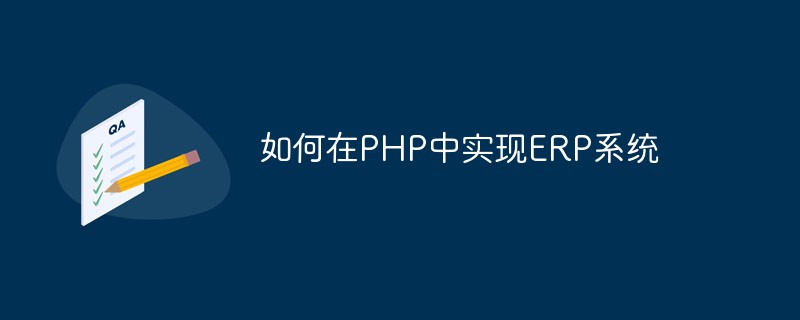 如何在PHP中实现ERP系统May 20, 2023 pm 06:21 PM
如何在PHP中实现ERP系统May 20, 2023 pm 06:21 PM随着电子商务和企业管理的发展,许多企业开始寻找更好的方法来处理其日常业务流程。ERP系统是一种能够整合企业各种业务流程的软件工具。它提供了全面的功能,包括生产、销售、采购、库存、财务等方面,帮助企业提高效率、控制成本和提高客户满意度。而在PHP编程语言中,也能够实现ERP系统,这就需要我们掌握一些基本的知识和技术。下面,我们将深入探讨如何在PHP中实现ERP
 在PHP中如何实现物联网开发?May 12, 2023 am 11:51 AM
在PHP中如何实现物联网开发?May 12, 2023 am 11:51 AM随着物联网技术的发展和普及,越来越多的应用场景需要使用PHP语言进行物联网开发。PHP作为一种广泛应用于Web开发的脚本语言,它的易学易用、开发速度快、可扩展性强等特点,使其成为开发物联网应用的一种优秀选择。本文将介绍在PHP中实现物联网开发的常用技术和方法。一、传输协议和数据格式物联网设备通常使用TCP/IP或UDP协议进行数据传输,而HTTP协议是一个优
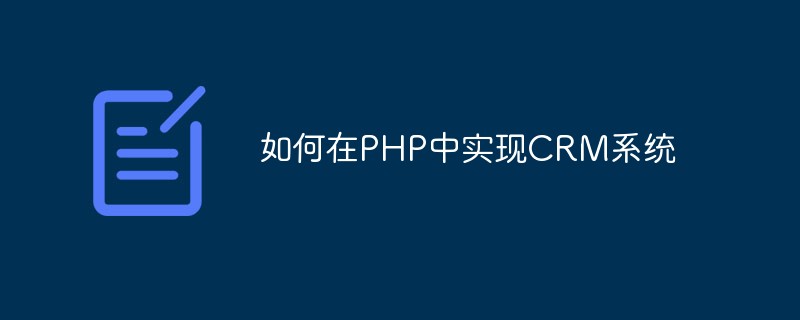 如何在PHP中实现CRM系统May 20, 2023 pm 12:31 PM
如何在PHP中实现CRM系统May 20, 2023 pm 12:31 PM随着企业的发展,客户管理变得越来越重要。为了提高客户满意度和忠诚度,越来越多的企业采用客户关系管理系统(CRM)来帮助其管理客户关系。而PHP是一种流行的编程语言,因其简单易学、灵活和强大而被广泛应用于Web开发。那么,如何在PHP中实现CRM系统呢?本文将为您介绍实现CRM系统的步骤和技巧。Step1:需求分析在开始开发CRM系统之前,您需要进行需求分析
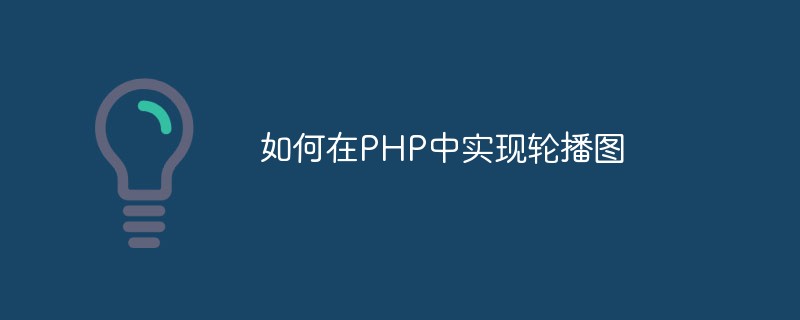 如何在PHP中实现轮播图May 22, 2023 am 08:25 AM
如何在PHP中实现轮播图May 22, 2023 am 08:25 AM随着互联网的发展,轮播图已经成为了网页设计中必不可少的一部分。在很多网页中,轮播图经常被用作展示企业文化、最新产品或是推广活动等场景。本篇文章将会分享如何使用PHP来实现轮播图的功能。一、轮播图的概念轮播图是网页中一种常见的视觉效果,一般由多个图片组成,在页面中自动或手动进行切换,展示多个内容。可以添加符合业务要求的动画效果,有助于引起用户的关注和提高网站的
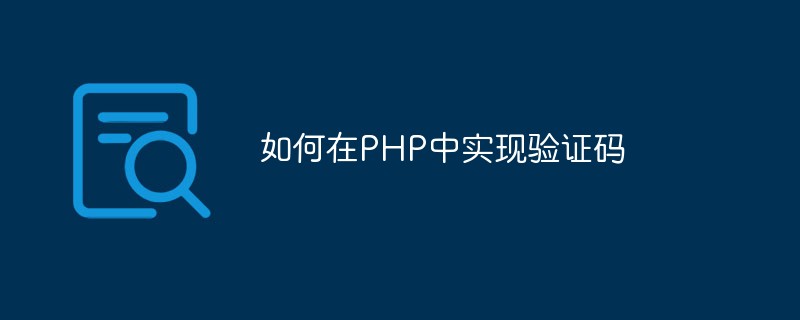 如何在PHP中实现验证码May 20, 2023 am 11:31 AM
如何在PHP中实现验证码May 20, 2023 am 11:31 AM随着互联网的不断发展,越来越多的网站需要使用验证码来保证安全性。验证码是一种借助人类能力而无法被计算机破解的认证技术,广泛应用于网站注册、登录、找回密码等功能中。下面将介绍如何使用PHP实现验证码功能。一、生成验证码图片验证码图片的生成是验证码功能的核心,需要生成一个随机字符,并将其渲染为图像展示给用户。在PHP中,可以使用GD库来生成图片。GD库是一种用于
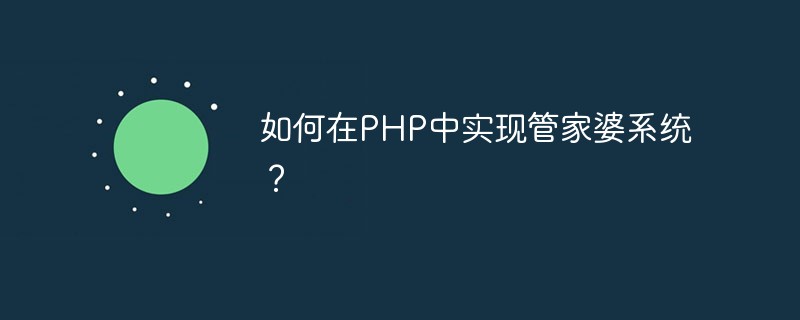 如何在PHP中实现管家婆系统?May 12, 2023 am 08:12 AM
如何在PHP中实现管家婆系统?May 12, 2023 am 08:12 AM管家婆系统在现代企业管理中扮演着重要的角色,它不仅仅能够有效地提高企业的工作效率,还可以大大提高了企业的生产力和竞争力。与此同时,PHP作为一种广泛使用的动态脚本语言,也受到了许多企业的青睐。接下来,我们将探讨如何在PHP中实现管家婆系统,以提高企业的管理效率。一、了解管家婆系统管家婆系统是一种企业管理软件,主要用于管理公司的财务、销售、采购、仓库、人力资源
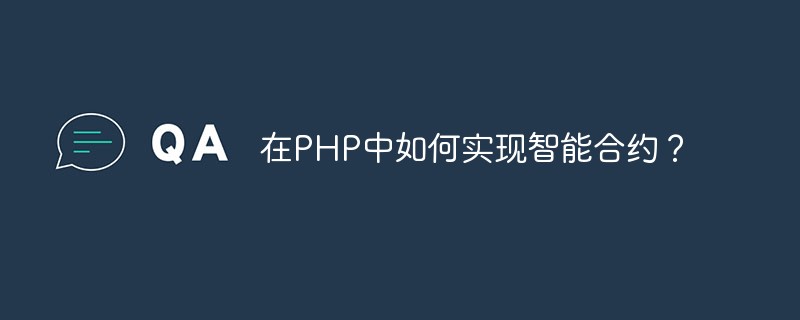 在PHP中如何实现智能合约?May 12, 2023 am 08:09 AM
在PHP中如何实现智能合约?May 12, 2023 am 08:09 AM智能合约(SmartContract)是一种基于区块链的自动化交易程序,可以实现自动化执行、验证和执行交易。智能合约可以减少交易中的人为干扰,提高交易的安全性和效率。在不同的区块链中,智能合约的实现方式略有不同。本文将介绍在PHP中如何实现智能合约。PHP是一种广泛使用的编程语言,特别适合Web开发。PHP有着成熟的开源生态系统,以及许多可靠的框架和库。在


熱AI工具

Undresser.AI Undress
人工智慧驅動的應用程序,用於創建逼真的裸體照片

AI Clothes Remover
用於從照片中去除衣服的線上人工智慧工具。

Undress AI Tool
免費脫衣圖片

Clothoff.io
AI脫衣器

AI Hentai Generator
免費產生 AI 無盡。

熱門文章

熱工具

SublimeText3漢化版
中文版,非常好用

SublimeText3 Mac版
神級程式碼編輯軟體(SublimeText3)

MantisBT
Mantis是一個易於部署的基於Web的缺陷追蹤工具,用於幫助產品缺陷追蹤。它需要PHP、MySQL和一個Web伺服器。請查看我們的演示和託管服務。

Dreamweaver CS6
視覺化網頁開發工具

DVWA
Damn Vulnerable Web App (DVWA) 是一個PHP/MySQL的Web應用程序,非常容易受到攻擊。它的主要目標是成為安全專業人員在合法環境中測試自己的技能和工具的輔助工具,幫助Web開發人員更好地理解保護網路應用程式的過程,並幫助教師/學生在課堂環境中教授/學習Web應用程式安全性。 DVWA的目標是透過簡單直接的介面練習一些最常見的Web漏洞,難度各不相同。請注意,該軟體中





